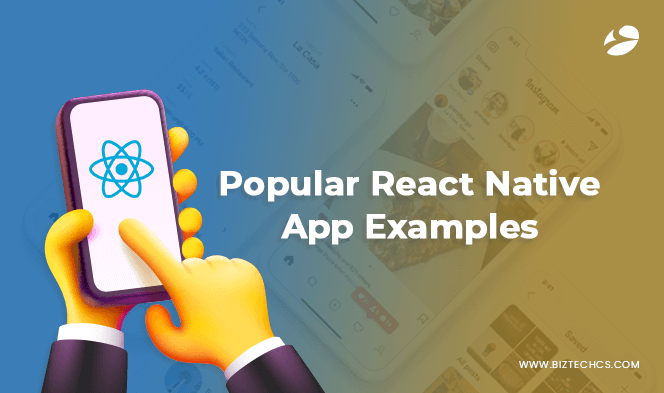2043
16 Most Popular React Native Apps in 2022
17 Aug, 2022
9 min read
2043
17 Aug, 2022
9 min read
Table Of Content

With thousands of apps using React Native, you may have this question – Can I build an app with React Native? Is the technology mature and versatile enough to be a part of my tech stack?
So, as an answer to your questions, we wrote this article. Here you can access the best examples of React Native apps from different industries.
Since its release in 2015, React Native has provided businesses with native ways to customize their business. Its simplicity, native approach, performance, and testability have made it the right and preferred choice for developers and business owners.
So if you’re curious about what you can achieve with React, check out these 16+ mobile apps written in React Native.
Fortune 500 companies like Walmart, Salesforce, Shopify, Meta, and Instagram use React Native-based mobile applications and websites for different reasons.
Well, they are still using it, unlike the rumors that say otherwise.
Why won’t they? React Native is a result of the hackathon Meta organized to meet the company’s needs for mobile development.
They wanted to leverage the benefits of web development like rapid iterations and to develop an entire product as a single team. Consequently, they did it for both Android and iOS applications with React Native.
Initially, the developers at Meta converted the EventsDashboard feature to React native to test the performance.
The result?
A React Native Meta app with twice the performance!
Apart from its social app, Meta also shifted its Meta Ads Manager to React Native. It was the first React Native-based cross-platform app.
Initially, it was difficult to handle the increasing number of features, complex business logic, and variances in ad formats, time zones, currencies, date formats, currency norms, and more was difficult. React Native appeared ideal as a large portion of it was written in JavaScript.
The framework provides an intuitive user experience while the animations and transitions remain flawless. With a switch to React Native, the app speed has increased. Whether users want to monitor the progress of existing campaigns or create a new one, they can do so in a blink of an eye! It’s lightning fast!
 Instagram is another React Native-based mobile application.
Instagram is another React Native-based mobile application.
Instead of creating an app from scratch, they integrated React Native into their existing app with a basic view – push notifications view. They implemented it as a web view as it didn’t require navigational infrastructure; the UI was relatively straightforward.
React Native allowed Instagram product teams to ship features faster through code sharing and high iterations for Android and iOS. Instagram developers were able to promote various features like Post Promote, Save Posts, CheckPoints, Comment Moderation, Lead Gen Ads, etc., to React Native.
Instagram improved its developer velocity, thanks to the percentage of code React Native shared.
Read about React Native at Instagram
Walmart shifted to React Native to develop a cross-platform app when maintaining the hybrid app became expensive and time-consuming.
They wanted to enhance their customer’s shopping experience, and their old app fell behind customers’ demands. The performance of the hybrid views wasn’t great because web views depended on network requests. So, users with slower connections had a rough experience.
While hunting for answers to provide a smoother experience, they came across React Native. With React Native, they were able to increase productivity, time to market, performance, and UX. They could share 95 percent of the code between Android and iOS.

Read the story of Walmart – a React Native Project Example.
“Mobile apps with React Native are the future of mobiles.”, says Shopify, after years of experimenting with native development.
They looked at React Native for mobile app development in 2015, but the technology was new.
Thus, they started experimenting with React Native with three different teams over three different applications – Arrive, Compass, and Point of Scale. They learned that:
This is why they started developing all their new apps in React Native.
You can read more about Shopify’s experience with React Native.
Tableau started rewriting its apps in React Native in 2017 because of the cross-platform capabilities. Back then, they weren’t large enough to handle separate codebases for Android and iOS.
They moved on to React Native because of the fast iterations, higher productivity, cross-platform compatibility, community, and ease of integration with native code.
The result? They released new apps in 2019, enjoying lower crash rates and positive feedback from users. Tableau’s app usage has grown by 60 percent since then. They could achieve more than they had expected while switching to React.

Here’s their story – React Native at Tableau 3 years in.
Discord has been using React Native for its iOS app since Meta open-sourced it in 2015. Their iOS app is
They did try it for their Android app. However, they stopped after identifying issues such as poor touch events performance and lack of 64-bit support. They kept experimenting with their iOS app and the capabilities of React Native. There were challenges in the implementation, but the results achieved were outstanding!

Image Source: screenlane.com
After the successful growth of its iOS app with React Native, Discord is switching to React Native for its Android app.
React Native is mature and stable now. It will allow the Discord dev team to streamline processes and push updates more frequently. Discord Android users can now enjoy faster app update cycles.
Pinterest considered React Native to leverage the benefits it offers. One of the key benefits is an increase in developer velocity. As React Native enables code sharing between platforms, saving implementation time. It means less time for meetings and fewer inconsistencies between the platforms.
High optimized performance was another benefit that made Pinterest view React Native as an additional tool in their engineering toolbox alongside existing native code capabilities.
Pinterest never intended to go entirely React Native, but one at a time, they are exploring and evolving with React Native.

Here’s more on supporting React Native on Pinterest.
Often, we search for mobile apps made in React Native. However, React Native is not limited to mobiles! Microsoft is leveraging React Native for its Windows 11 Settings App.
The team wanted to balance functionalities and user experience between native and web versions. They wanted to reuse code without having to duplicate code.
React Native made it possible! It enabled them to share business code logic, deliver new features to customers, and increase developers’ productivity – while leveraging the native platform’s fidelity, performance, and accessibility.
 P.S. Microsoft also uses React Native for Microsoft Outlook, Microsoft Teams, and Microsoft Office.
P.S. Microsoft also uses React Native for Microsoft Outlook, Microsoft Teams, and Microsoft Office.
In 2020, Coinbase rewrote its Android app from scratch to React Native due to following reasons:

By switching to React Native, the Coinbase team could share more code and deliver faster while maintaining higher standards for quality, performance, and cybersecurity.
Read the whole story about their successful transition to React Native.
Bloomberg – a news platform, is one of the popular React Native app examples. They used React Native to build their consumer app to offer a more unified look and feel with their branding strategy.

Image Source: fifthperson.com
With React Native, they were able to merge their native apps and build a cross-platform application. The performance increased, and the results they achieved were as follows:
Tesla – a well-known electric vehicle manufacturer, has created an app using React Native for their customers who have electric cars and their Powerwall batteries. The app can diagnose cars and even control them partially.
 Users have complimented Tesla’s app!
Users have complimented Tesla’s app!

The Vogue app is built in React Native. It provides users with the latest fashion, beauty, celebrity styles, homes, weddings, lifestyles, food, travel, and entertainment news.
Since Microsoft uses React Native for Windows, writing an Xbox app in React Native is obvious. The Xbox app provides a premium experience, smooth animations, and video play.
With React Native, Xbox developers can target a huge community beyond mobile. The native capabilities of React make the app faster, safer, and easier to use than before.
Mercari is a Japanese eCommerce company that rewrote its native apps in React Native from scratch. The reason was to leverage the benefits of React Native – code reusability, higher engineering throughput, increased performance, cross-platform initiatives, accessibility support, etc.

The result? An unprecedented growth. The team at Mercari believes that implementing React Native completely will decrease their crash rate by 98 percent. That’s huge!

According to NerdWallet, the React Native framework has unlocked key strategic wins, including reduced time-to-market, impressive development efficiency, and improved app performance.
In case you are working on a React-based project, then it is advisable to use the React Admin Template. Using such admin templates will save you a lot of time and money.
Various other apps, including Foreca, Artsy, Adidas Glitch, Tencent QQ, Delivery.com, Gyroscope, Huiseoul, JD, SoundCloud Pulse, and Townske, use React Native to leverage its cross-platform and code sharing capabilities.
Some apps, such as Airbnb, no longer use React Native; you may also hear that React Native is not in demand in 2022. That’s just a rumor!
React Native has grown exponentially. It has reached maturity and proven to be a reliable framework for cross-platform development.
If you’re thinking about React Native development, you can reach out to us! We provide custom enterprise mobile app development services for different technologies.
Or, if you want some skilled and experienced developers to work with your in-house team, you can even hire React developers from us! We understand the challenges and will help you with the transition!
You can explore our work here – Our Portfolio.

68
By Biztech
09 Oct, 2025

74
By Biztech
09 Oct, 2025

91
By Biztech
06 Oct, 2025